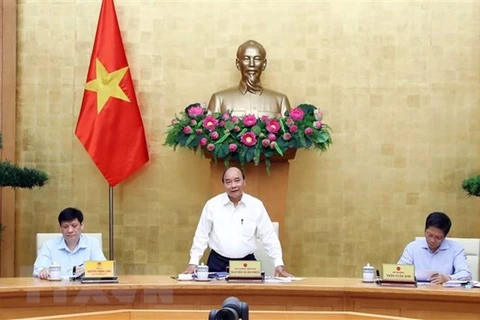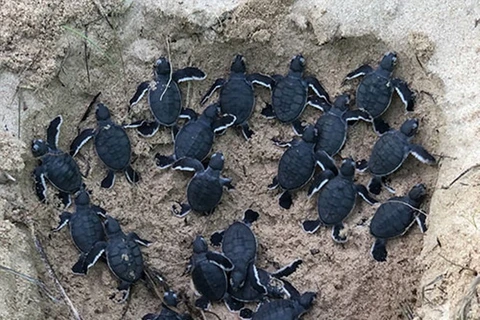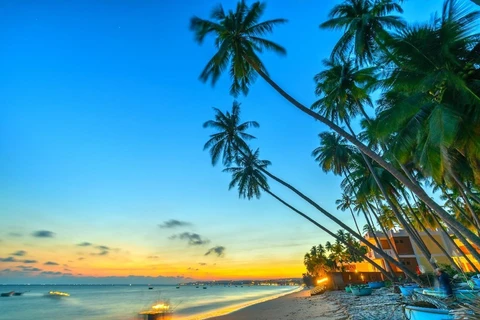 Tourism is expected to become a spearhead economic sector of the central province of Binh Thuan. (Photo: VNA)
Tourism is expected to become a spearhead economic sector of the central province of Binh Thuan. (Photo: VNA) Binh Thuan (VNA) - With a 192km-long coastline and 52,000sq.km fishing ground, the south central province of Binh Thuan has great potential for marine economy development. The locality, with largest titanium reserve, has also implemented many tourism, energy and industrial projects.
In a recent interview with the Vietnam News Agency, Secretary of Binh Thuan Province’s Party Committee Duong Van An talked about the development strategy of the locality and recommendations made to the Government to tap its huge potential, making the province rich in economy and strong in defence and security.
- With great potential in the ocean’s natural resources and important location, what are the orientations and solutions to develop the marine economy in association with ensuring sea and islands sovereignty protection of Binh Thuan province?
Binh Thuan is a coastal central southern province with 192km of coast line, where international ships pass through. With 52,000sq.km of fishing area, this province is one of the three key fishing grounds of Vietnam. Its Phu Quy Island district has a strategic location in marine economy and security and defence. There are also oil and gas fields in the water of the province. We have huge potential to develop the marine economy especially tourism, renewable energy and seafood exploitation and processing, in association with the island and sea sovereignty protection.
The Binh Thuan provincial Party Committee issued an action plan to make the province become one with a strong, sustainable and comprehensive marine economy. In order to achieve the goals, the province also takes into account other tasks including conservation, climate change, marine environment protection and coastal encroachment prevention, among others.
The coastal area will become a driving force to promote growth with the development of urban and tourist areas, coastal industrial and service zones and clusters, along with renewable energy and seaport system development. The priority industries include tourism, energy, manufacturing and processing and logistic services.
In tourism for example, the province will build many luxury tourism areas with resorts, ecology, heath treatment and water sports. In the next five years, tourism is expected to become a spearhead economic sector. Mui Ne National Tourism Zone is targeted to be one of the leading destinations in the Asia-Pacific region in the next 10 years.
In industry, the province will promote both manufacturing and processing, and energy industries. It prioritises offshore wind power and Liquefied Natural Gas power projects. Offshore wind power is a new industry that is both cost-effective and sustainable. Several local and foreign investors have looked at investment opportunities and asked for permission to survey the wind power projects with the total capacity of up to 22,000MW. However, it should be noted that whether they are to be approved or not also depends on the National Power Development Master Plan in 2021-2030 and other sea and island-related issues.
To achieve the goals, the province has accelerated the construction of the infrastructure system in coastal areas and Phu Quy Island. Many structures have been or are being built, including Ham Tan-La Gi industrial, service and urban zone in Ham Tan district, coastal roads and logistics facilities for fishing. In addition, the province has strengthened the capacity of the fishery surveillance forces to protect aquatic resources and combat illegal unreported and unregulated fishing.
We also aim to develop Phu Quy Island district to ensure that it can fulfil the marine security and defence tasks and serve as a logistical and technical base for Truong Sa (Spratly) Archipelago and the DK1 rigs. Phu Quy will also serve as a marine search and rescue centre for the central southern region.
At the same time, the province will strengthen its national defence capacity, build a strong armed force, enhance its combat readiness and meet the requirements of protecting sovereignty over sea and islands. It will also focus on building and consolidating the all-people defence as well as strengthen the efficiency of law enforcement forces at sea. At the same time, it will pay attention to improving the life quality of locals in coastal localities and Phu Quy Island district.
- Could you tell us more about the proposals and recommendations of Binh Thuan province to the 13th National Party Congress on the task of marine economy development in association with sovereignty protection in the upcoming term?
Tapping sea and island potentials is a significant and strategic issue in most countries especially in the context that the resources on land are becoming exhausting. The resolution on the strategy for the sustainable development of Vietnam’s marine economy to 2030 and vision to 2045, known as Resolution No 36, affirmed that Vietnam will be a strong and rich country based on the sea. The marine economy is not merely about fishing and exploitation of the ocean’s natural resources. The combination of sectors; marine infrastructure; socio-economic, security and defence factors all contribute to the development of the marine economy.
Despite impressive achievements, Vietnam has yet to tap the potentials of a country with more than 3,000km-long coastline. There are shortcomings in the development process including the unsustainable development, lack of planning and poor management. Fishing activities have not been controlled properly, leading to the depletion of aquatic resources.
Sustainable development of the marine economy in association with sovereignty protection is an imperative and strategic, long-term task. To this end, it is necessary to develop sectors that have high added-value, use modern technologies and are environmentally friendly while still ensuring the security and defence as well as protecting the sovereignty of the nation.
Vietnam is among the most vulnerable countries to climate change, therefore it needs to work on solutions to protect the ocean environment and develop the marine economy sustainably.
Binh Thuan aims to become a province strong in ocean economy. The province has many solutions to develop its maritime economy and has achieved positive initial results, however, there is still much room to tap its potentials and make breakthroughs.
One of the projects much anticipated by locals is Phan Thiet airport. The plan to build an airport in Phan Thiet was approved by the then Prime Minister Nguyen Tan Dung in 2014 and it will be used for both civil and military purposes. Nearly 600ha of land have been cleared ready to build an airport. We hope that Prime Minister Nguyen Xuan Phuc will direct competent authorities to accelerate the progress of the project to put the airport into operation soon.
Investment in some projects in Binh Thuan is also facing legal difficulties. Binh Thuan province has the largest titanium reserve in the country with more than 82,000ha, accounting for some 10 per cent of the province’s total land.
We hope that permission will be given for the implementation of development projects on the surface of areas of mineral reserves.
With 192km-long coastline, Binh Thuan has many beautiful beaches for tourism development. However many have also degraded by erosion. We hope that the Government has programmes to support the building of sea dykes which are used for both erosion prevention and military defence purposes.
For Phu Quy, we hope to continue to receive support and investment from the Government so that this will be a district rich in economy and strong in defence and security./.























